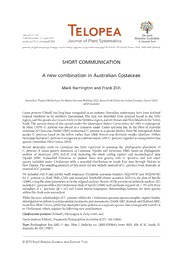
A new combination in Australian Costaceae PDF
Preview A new combination in Australian Costaceae
Telopea Volume 14: 9-10 The Royal Publication date: 16 August 2012 Botanic Gardens Journal of Plant Systematics dx.doi.org/10.7751/telopea2012003 & Domain Trust plantnet.rbgsyd.nsw.gov.au/Telopea • escholarship.usyd.edu.au/journals/index.php/TEL • ISSN 0312-9764 (Print) • ISSN 2200-4025 (Online) SHORT COMMUNICATION A new combination in Australian Costaceae Mark Harrington and Frank Zich Australian Tropical Herbarium, Sir Robert Norman Building (E2), James Cook University Cairns Campus, Cairns QLD 4870 Australia Costus potierae F.Muell. has long been recognised as an endemic Australian understorey herb from lowland tropical rainforest in far northern Queensland. The type was described from material found in the Tully region, and the species also occurs rarely in the Daintree region, and on Dauan and Moa Islands in the Torres Strait. The current status of this species under the Queensland Nature Conservation Act 1992 is endangered. In Maas (1979) C. potierae was placed as a synonym under Costus speciosus Sm. In the Flora of Australia treatment of Costaceae, Smith (1987) maintained C. potierae as a species distinct from the widespread Asian species C. speciosus based on the yellow rather than white flowers and distinctly smaller labellum. Within Australian herbaria C. potierae is recognised as a distinct taxon, with C. speciosus regarded as misapplied to this species (Australian Plant Census, 2010). Recent molecular work on Costaceae has been equivocal in assessing the phylogenetic placement of C. potierae. A recent generic treatment of Costaceae (Specht and Stevenson 2006) based on phylogenetic analysis of molecular (ITS, trnL-T, trnK including the matK coding region) and morphological data (Specht 2006) reclassified Costaceae to include three new genera, with C. speciosus and two other species included under Cheilocostus with a recorded distribution in South East Asia through Malesia to New Guinea. The sampling protocol of this study did not include material of C. speciosus from Australia or material of C. potierae. We included trnL-T and partial matK sequences (GenBank accession numbers HQ234747 and HQ234748) for C. potierae (A. Ford 3805, CNS) and reanalysed TreeBASE Matrix accession M25114, the data of Specht (2006), using the same parameters as in the original analyses. Results of the parsimony jackknife analyses (jk) included C. potierae within the Cheilocostus clade of Specht (2006) with moderate support (jk =78) with three exemplars of C. speciosus (jk = 62) and Costus lacerus Gagnepain. Relationships between the three species within this clade were unresolved. While the exact relationships of C. potierae within the Cheilocostus speciosus species complex require further investigation we follow recent taxonomic treatments and assessments (Smith 1987, Bostock and Holland 2007, Australian Plant Census, 2010) that maintain Costus potierae as a separate species, and consequently transfer it to Cheilocostus, which requires the following new combination: Cheilocostus potierae (F.Muell.) Harrington & Zich, comb. nov. Costus potierae F.Muell., Fragmenta Phytographiae Australiae 4(27): 164 (1864). Type: Rockingham Bay, Qld, 17 Apr. 1864, J. Dallachy s.n. (MEL92956A); lecto: MEL, fide R. M. Smith, Fl. Australia 45: 453 (1987). © 2012 Royal Botanic Gardens and Domain Trust 10 Telopea 14: 9-10, 2012 Harrington and Zich References Australian Plant Census, IBIS database, Centre for Plant Biodiversity Research, Council of Heads of Australian Herbaria, (http://www.chah.gov.au/apc/index.html) (viewed 1 April 2010) Bostock PD & Holland AE (eds) (2007) Census of the Queensland Flora 2007. (Queensland Herbarium, Environmental Protection Agency: Brisbane) Maas PJ (1979) Notes of Asiatic and Australian Costoideae (Zingiberaceae). Blumea 25: 543-549. Smith RM (1987) Pp 35,36,453, Map 36 in George AS (ed.) Flora of Australia, vol 45. (Australian Government Publishing Service: Canberra) Specht CD (2006) Systematics and evolution of the tropical monocot family Costaceae (Zingiberales): a multiple dataset approach. Systematic Botany 31: 88-105. Specht CD & Stevenson DW (2006) A new phylogeny-based generic classification of Costaceae (Zingiberales). Taxon 55: 153-163. Manuscript submitted 02 August 2010, accepted 09 February 2012
